While it’s not a hard and fast rule, my advice for home battery owners who are moving house is this: once they’re installed, batteries are better value staying put. While batteries are expensive, moving them is doubly so.
As home batteries proliferate, folks are increasingly interested in taking their expensive technology with them to the next house they buy or build. We’ve had a flurry of emails recently along the lines of:
There’s a 10-year warranty and money to be saved; why would I want to give it away?
Our answer: Because there’s a good chance you can sell an installed battery for more than it’s worth, provided you make a feature of it.
The trick is getting the used house salespeople to realise listing the battery along with the butler’s pantry and bidet can add ten grand to the sticker price and probably $200 to their commission.
Real Estate Agents Are Getting There. Slowly.
A great mate of mine sold his house a dozen years ago. Despite telling them, the salespeople didn’t list the solar at all, meaning the new owner has picked up well north of $15,000 value since.
While I’ve recently seen solar featured in a house description and even references to size and an old gold feed-in tariff, I’m keen to see real estate adverts have a screenshot of a low energy bill next to the floor plan.
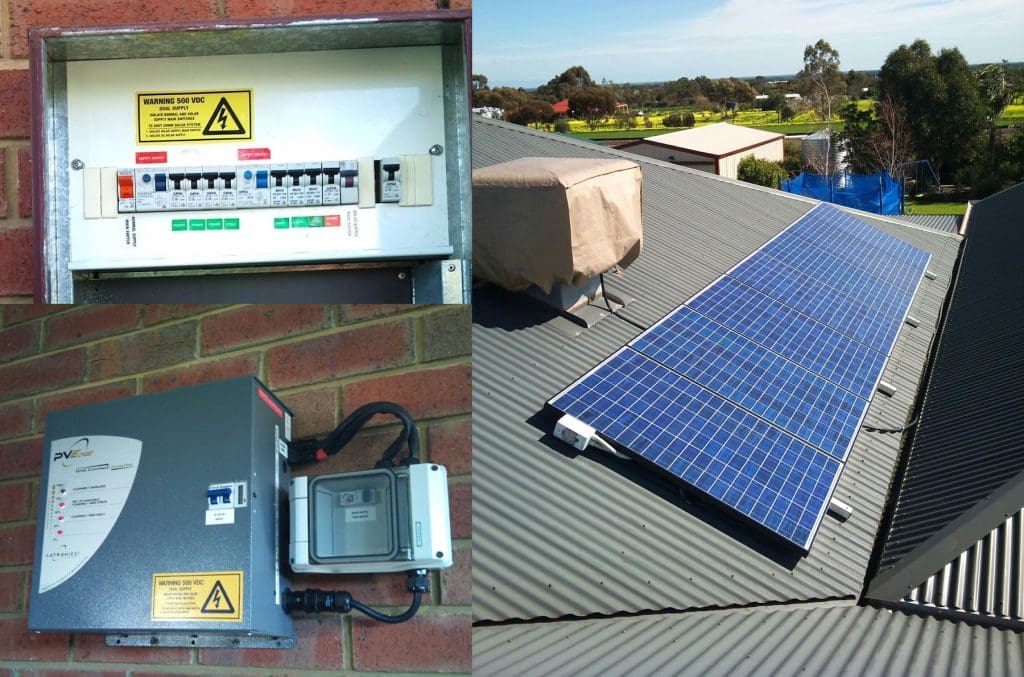
Panels invisible behind the pergola, I guess the grey box on the garage wall didn’t look like $10,000 so the estate agent ignored it.
Labour Is Expensive
NECA recommends charging $114/hr for electrical service work and 76c/km for travel. If those rates sound reasonable, it’s because they’re over 10 years old.
So when you get a quote for battery removal & making it safe, then packaging, loading, transport, plus the longer process of reinstallation using new cable and consumables, it could easily be a full day’s work once commissioning is included.
You’ll finish up with a secondhand battery, an unclear warranty, plus holes in the wall to repair before you can hand over the keys to the old place.
Temporary Battery System?
I keep banging on about stand-alone power systems as hybrids because, for some niches, there’s nothing better. As the name suggests, off-grid, remote area or stand-alone power is something we used to build onto a board in the workshop. Come installation day, it could be unloaded, batteries attached and power switched on before morning smoko.
If you’re in a rental property or planning to move, these kinds of systems are inherently portable and reassuringly expensive.
If I leave my house, the solar panels will stay on the roof, but like in the image below, the rest could be manhandled into a trailer in a couple of hours. It’s worth doing because integrating three separate inverters, a regulator, a battery, and interconnecting wiring onto a single switchboard requires a lot of labour.
However, if the new owner will front enough money, I’ll happily leave it all behind.
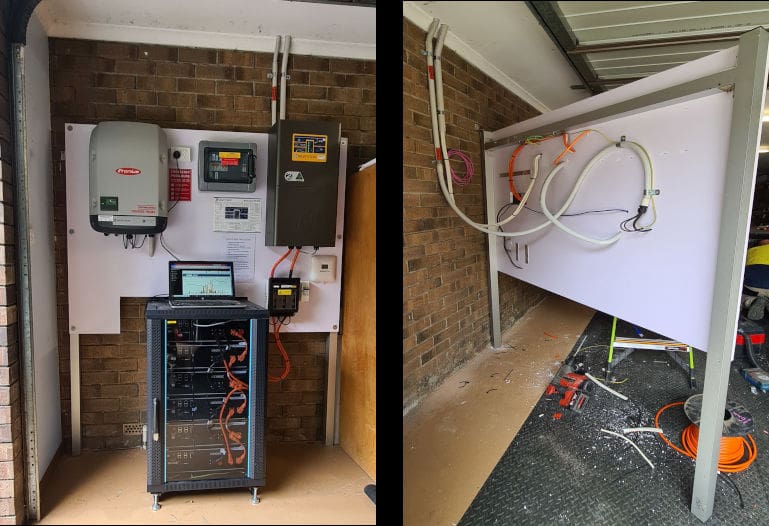
This fairly simple “stand-alone” system uses the grid as a backup generator.
Powerwall Is Almost Portable
AC-coupled batteries are designed as universally compatible, so if it weren’t for the gateway wired into your house mains, Tesla’s Powerwall 2 would be simple to move. Enphase batteries might also be redeployed if your new place has enough space for them.
However, you must know if the DNSP you’re moving to will allow you to connect their poles and wires to a battery that could be technically obsolete. New models are constantly being released, and old ones slip off the approved equipment lists as certificates expire or rules change.
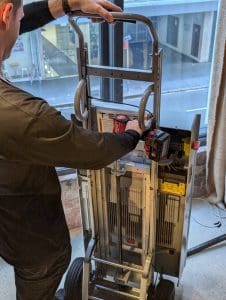
The new Powerwall 3 is such a heavy beast that Tesla is selling custom lifting trolleys to move it, while Enphase sells removable handles for its very bulky solution.
Batteries With Hybrid Inverters Make Sense; Moving Them Doesn’t
When you install solar power, the glass on the roof is effectively free because STC incentives (the rebate) are available on new installs. However, once the money is claimed, you can’t get a second rebate for solar on your new property if you re-use your old hybrid inverter (but you can with a brand new inverter).
If your new property already has solar, adding your hybrid inverter might still be problematic. Solar technology moves fast so connection approvals with your poles and wires authority hinge on equipment being on a current list, and it’s likely your old inverter dropped off that list some time ago.
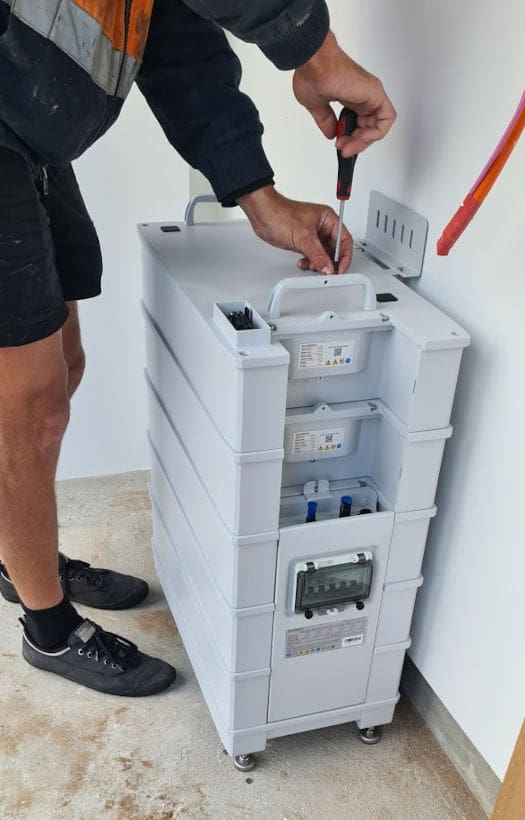
With integrated handles, it’s simple enough to lift at least two of these Sungrow cell blocks off and take them away.
Monolith or Modular; Some DC Batteries Might Move Easily
If the system on your existing house is recent and you’re looking at the same model to replicate it at the next address, taking some of the battery modules with you could be feasible.
If you have a stack of eight 3.2kWh Sungrow cells, for example, five of them could be relocated quite easily. You’d need a qualified technician, but it shouldn’t be any more trouble than Finn went to expanding his own system recently.
Be aware; the fine print of your warranty may foil these plans. I’m sure some prohibit moving premises, and I know that others don’t tolerate having batteries of different ages combined into a single stack or being taken out of service and stored for some time while you build a new house. Manufacturers insist on monitoring for reasons like these, and if you disconnect them, then your ten-year coverage can be reduced to just three.
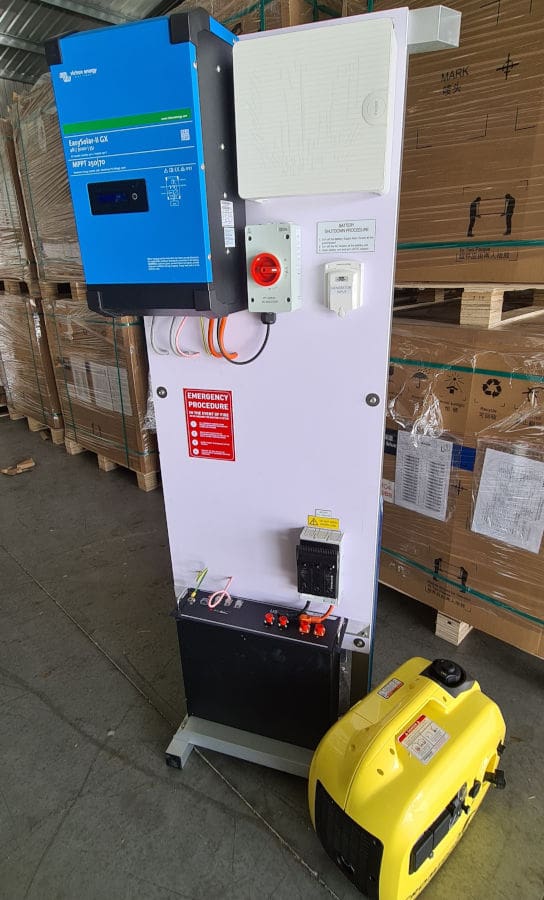
Just add solar. This self-contained 3kWp/3kWh stand-alone system could be installed in your camper van or on the verandah of your house.
Plan Your Move
While I wouldn’t recommend moving a battery, there are instances when it may make sense. If you intend to, ensure you have an installer on the same page and a viable plan to keep the warranty intact and the hardware safe.
For a cleaner, easier and safer process, where everyone is a winner, I’d leave your existing home battery in its original and compliant place and set about getting a fresh system in your new abode.
For a properly portable battery, the best advice I can offer is to get one with a steering wheel and stop paying petrol bills. Add a heat pump hot water service, or solar diverter, and you’ll also gain a dozen kilowatt-hours of thermal energy storage.
And remember that you’re free to move furniture, but if something is screwed down when you sign the sale contract, it has to stay with the property.


 RSS - Posts
RSS - Posts



I agree the battery with wheels and a
steering wheel makes more sense and also has
more capacity.
So as I understand it a new inverter and PV array is generally limited so that the wattage of the PV array is no more than 133% of the rated inverter output.
The same system and inverter (where it is Hybrid) if it has a battery connected may well exceed that 133% mark to allow the Battery to charge as well as the inverter to generate 240v output at the same time.
In those circumstances where the system is beyond 133% and you remove the battery for a move does the remaining parts of the original system remain compliant? Or would you need to remove some of the PV array back so that it doesn’t exceed the 133% mark.
If that is the case (and I don’t know if it is) then if moving a battery is labour intensive (and I don’t think it really is that labour intensive in the case of Sungrow or similar modular battery’s) but much more so to rewire and downsize solar strings imho….. especially as you still want to have appropriately high String series voltages to minimise losses and to have them balanced across multiple MPPT inputs…..yuck!!
If its not the case then a battery installed for a day before you changed your mind is all that would be needed to avoid the 133% limit as it is today……. (Yeah I can see that flying….NOT!)
Andy
Andy I like your thinking.
133% is a stupid rule and needs some innovative ideas to circumvent.
I might ask the CER
You don’t need to downsize the solar.
That rule has nothing to do with the inverter. It was originally purely a made-up rule by the CEC.
You power company approved the the amount of PV, Inverter capacity and feedin limit. I checked the Energex contract in QLD and there is no mention of reducing capacity when removing or shutting down the battery.
I would have thought a solar system being fixed to roof/walls etc was a fixture and part of a dwelling anyway and not to be moved, how to seal roofs of fixing holes etc. just a thought.
Yes. They are the same as air conditioning plant.
Real Estate contracts for sale specify inclusions and exclusions for that very reason.
Without that 133%rule in the olden days when FIT’s where a reasonable value it would have made sense to completely oversize the array (and the STC’s that move generated) so that the inverter delivered its max output no matter what the conditions of the day, or the season of the year…. assuming that the other stupidity of no more than 5kw of inverter was also enforced…. but then you were always able to move to 3phase if your local grid circumstances allowed (and in the country it often doesn’t…at least at a cost that people might want to pay)
Now that FIT’s and midday penalty’s to FIT’s (which in my opinion are what they are because we dont have enough pumped solar Hydro schemes actually on line to consume those Midday Solar peaks)the 133% rule becomes irrelevant, after all whose going to pay more to maximise their inverters output so they can maybe pick up 2-3c per MWhr?
Of course as Battery’s become De jouir and people learn that the latest Hybrid inverters can delay Battery charging until the middle of the day instead of first thing in the morning I can see the Midday Solar peak going the way of large FIT’s even if the Pumped Hydros actually ever come on line…..
The Renewables led electricity market is nothing if a moving feast hey? To make a $ in that market requires starting with multiple $ and accepting that you might exist with a $ if lucky and the rules don’t change for the worse before the supposed income is actually earned…
Battery’s don’t make financial sense yet and yet more and more of us are moving that way….with all the volatility that causes to a market economy in play.
I continue to watch with barely hidden enthusiasm for the next chapter… meanwhile the world cooks!
Andy
We are planning on doing a knock down/rebuild of our current house into a duplex. We currently have a system that will be just over 2 years old by the time we start demolishing that has 24 x Risen RSM108-9-440N panels, Sungrow SH10RT Inverter and Sungrow SBR096 battery. Is it worth decommissioning, uninstalling, storing and recommissioning on the new building. What SOC should the battery have when being placed in storage? It could take 8-12 months before the system is working again. I assume it would be best to engage my original installer to work with the builder’s electrician so all the solar wiring is done by my guy to maintain warranty. Is this viable? This is a bit different to a straight relocation.
Hi Ian,
It’s a tricky question.
Firstly I would engage your original installer, then contact Sungrow with a general enquiry about the storage & SOC question.
If being out of service affects warranty you may be better off quitting the batteries second hand?
Old batteries will limit the capacity of any new ones you may add later.
The SH10RT is quite limited in backup capacity compared to newer series 15 or 20kW.
Risen panels are ok but more is better.
I would design the house with a 10° skillion roof for maximum PV, passive solar design, extra insulation, air tightness & HRV system. You only get to make these fundamental choices once.
Check the second & third link here…
https://www.solarquotes.com.au/search/?addsearch=builders